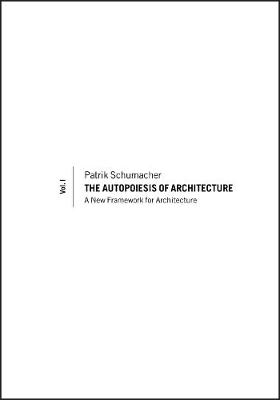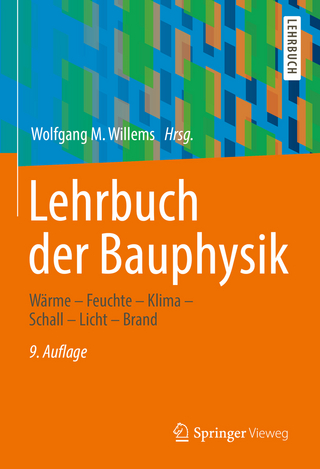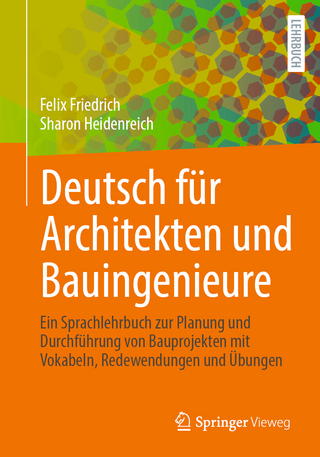
The Autopoiesis of Architecture, Volume I
John Wiley & Sons Inc (Verlag)
978-0-470-77298-0 (ISBN)
Take a theoretical approach to architecture with The Autopoiesis of Architecture, which presents the topic as a discipline with its own unique logic. Architecture's conception of itself is addressed as well as its development within wider contemporary society. Author Patrik Schumacher offers innovative treatment that enriches architectural theory with a coordinated arsenal of concepts facilitating both detailed analysis and insightful comparisons with other domains, such as art, science and politics. He explores how the various modes of communication comprising architecture depend upon each other, combine, and form a unique subsystem of society that co-evolves with other important autopoietic subsystems like art, science, politics and the economy.
The first of two volumes that together present a comprehensive account of architecture's autopoiesis, this book elaborates the theory of architecture?s autopoeisis in 8 parts, 50 sections and 200 chapters. Each of the 50 sections poses a thesis drawing a central message from the insights articulated within the respective section. The 200 chapters are gathering and sorting the accumulated intelligence of the discipline according to the new conceptual framework adopted, in order to catalyze and elaborate the new formulations and insights that are then encapsulated in the theses. However, while the theoretical work in the text of the chapters relies on the rigorous build up of a new theoretical language, the theses are written in ordinary language ? with the theoretical concepts placed in brackets. The full list of the 50 theses affords a convenient summary printed as appendix at the end of the book.
The second volume completes the analysis of the discourse and further proposes a new agenda for contemporary architecture in response to the challenges and opportunities that confront architectural design within the context of current societal and technological developments.
Patrik Schumacher is partner at Zaha Hadid Architects and founding director of the Design Research Laboratory (DRL) at the Architectural Association (AA) in London. He studied philosophy and architecture in Bonn, London and Stuttgart, where he received his architectural Diploma in 1990. In 1996 he founded the AADRL with Brett Steele, and continues to serve as one of its directors. In 1999 he completed his PhD at the Institute for Cultural Science, Klagenfurt University. Patrik Schumacher joined Zaha Hadid in 1988. Since then Zaha Hadid Architects has expanded from a small studio to a global ???rm employing over 300 architects. Patrik Schumacher's career continues to integrate practice and theory. His contribution to the discourse of contemporary architecture is also evident in his prior writings, such as Digital Hadid, 2004, as well as in his curatorial work for exhibitions, such as Latent Utopias, Graz, 2002. His essays are available on www.patrikschumacher.com.
Preface xi
0 Introduction: Architecture as Autopoietic System 1
0.1 Architecture as a System of Communications 1
0.2 A Unified Theory of Architecture 4
0.3 Functional vs Causal Explanations 14
0.4 The Quest for Comprehensiveness 17
0.5 The Premises Imported from Social Systems Theory 19
0.6 Architecture’s Place within Society 25
1 Architectural Theory 29
1.1 The Unity of Architecture 29
1.1.1 Architectural System-formation and Self-regulation 30
1.2 The Evolution of Architecture 32
1.2.1 Architectural Theory as Mechanism of Selection 33
1.3 The Necessity of Theory 35
1.3.1 The Function of Architectural Theory 36
1.3.2 Types of Theories 39
1.3.3 The Necessity to Reflect Architecture’s Societal raison d’être 47
1.3.4 Super-theories 54
1.3.5 The Theory of Architectural Autopoiesis as Domain-specific Super-theory 58
1.3.6 From Deconstruction to the Programme of Critical Theory 62
2 The Historical Emergence of Architecture 71
2.1 The Emergence of Architecture as Self-referential System 72
2.1.1 Inside-descriptions vs Outside-descriptions 72
2.1.2 Function Systems 74
2.1.3 The Historical Crystallization of Architecture 77
2.2 Foundation and Refoundation of Architecture 81
2.2.1 Autonomization: The Origin of the Discipline in the Italian Renaissance 81
2.2.2 The Refoundation of the Discipline as Modern Architecture 87
2.2.3 The Exclusive Competency and Universal Scope of Modern Architecture 89
2.2.4 The Liberation from Traditional Formal Constraints 91
2.2.5 The Switch from Edifice to Space 93
2.3 Avant-garde vs Mainstream 95
2.3.1 A Prerequisite for Evolution 97
2.3.2 The Autonomy of the Avant-garde 99
2.3.3 Communications between Avant-garde and Mainstream 102
2.3.4 The Reciprocal Dependency between Avant-garde and Mainstream 107
2.3.5 The Time Structure of the Avant-garde Process: Cumulative vs Revolutionary Periods 110
2.3.6 Concrete Exemplars vs Abstract Principles 115
2.3.7 Revolution and Philosophy 120
2.3.8 Latent Utopias vs the Utopian Ambitions of the Historical Avant-garde 123
2.3.9 Retroactive Manifestos 129
2.4 Architectural Research 132
2.4.1 Architectural Research as Avant-garde Design Research 133
2.4.2 Architecture Schools as Laboratories 138
2.5 The Necessity of Demarcation 144
2.5.1 The Differentiation of Art and Architecture 146
2.5.2 The Differentiation of Science and Architecture 155
2.5.3 The Differentiation of Architecture and Engineering 160
2.5.4 The Rationality of Demarcation 163
2.5.5 The Specificity of Architecture within the Design Disciplines 166
3 Architecture as Autopoietic System – Operations, Structures and Processes 171
3.1 Architectural Autopoiesis within Functionally Differentiated Society 177
3.1.1 Niklas Luhmann’s Theory of Modern Society 177
3.1.2 Third Order Observation 182
3.1.3 Codes and Media 183
3.1.4 The Concept of Social Autopoiesis 184
3.2 The Autonomy of Architecture 188
3.2.1 Openness through Closure 190
3.2.2 Irritations 193
3.2.3 Communication Structures 195
3.3 The Elemental Operation of Architecture 197
3.3.1 Design Decisions 199
3.3.2 Network-dependency of Elemental Operations 200
3.3.3 Design Decisions and External Demands 202
3.4 The Lead-distinction within Architecture and the Design Disciplines 204
3.4.1 The Primacy of Distinctions 205
3.4.2 Form vs Function as the Lead-distinction within the Design Disciplines 207
3.4.3 The Double Reference of the Design Disciplines 209
3.5 The Codification of Architecture 215
3.5.1 Binary Codes 217
3.5.2 Utility and Beauty as the Double Code of Architecture 219
3.5.3 Polycontexturality 224
3.5.4 The Unique Double Code of Architecture as Demarcation Device 226
3.5.5 The Double Code of Architecture and the Triple Code of Avant-garde Architecture 228
3.5.6 Discursive Oscillation: Coping with an Expanding Universe of Possibility 233
3.5.7 Abstraction and Openness 238
3.6 Architectural Styles 241
3.6.1 The Concept of Style(s) 241
3.6.2 The Rationality of Style(s) 254
3.6.3 Styles as the Necessary Programmes of Architecture 256
3.6.4 Styles Regulate Form and Function 258
3.6.5 Reluctant Styles 261
3.6.6 The Inescapability of the Formal A Priori 263
3.6.7 The Double Contingency of Style Formation 267
3.6.8 Stylistic Awareness as Second Order Observation 271
3.6.9 Progress as Progression of Styles 273
3.7 Styles as Research Programmes 277
3.7.1 The Creativity of Styles/Research Programmes 279
3.7.2 The Tenacity of Styles/Research Programmes 280
3.7.3 The Structure of Styles/Research Programmes: Autonomy, Hard Core, Heuristics 283
3.7.4 The Great Historical Styles: Hard Core and Heuristics 287
3.7.5 Problem Domain and Solution Space as Sources of Stylistic Innovation 290
3.7.6 Paradigmatic Mainline and Speculative Extrapolation 293
3.7.7 Progressive vs Degenerate Styles/Research Programmes 294
3.7.8 Methodological Tolerance 297
3.8 The Rationality of Aesthetic Values 300
3.8.1 The Historical Transformation of Aesthetic Values 302
3.8.2 Aesthetic Values and the Code of Beauty 305
3.8.3 The Mystery of Beauty 306
3.8.4 Formal A Priori, Idiom and Aesthetic Values 308
3.8.5 The Necessity of Aesthetic Revolutions 310
3.8.6 Aesthetic Values: Designers vs Users 313
3.9 The Double-nexus of Architectural Communications: Themes vs Projects 315
3.9.1 The Unity of the Difference between Themes and Projects 316
3.9.2 The Difference between Themes and Projects 317
3.9.3 The Interaction between Themes and Projects 318
4 The Medium of Architecture 323
4.1 Medium and Form 324
4.1.1 Symbolically Generalized Media of Communication 326
4.1.2 The Medium as Revealing and Concealing 330
4.1.3 The Medium as Universe of Possibilities 331
4.1.4 Medium and Manner 333
4.1.5 The Standard Medium of Architecture 335
4.1.6 Recursive Self-reference 338
4.2 The Medium and the Time Structure of the Design Process 342
4.2.1 Diff ´erance: The Productive Vagueness of the Medium 342
4.2.2 The Diagram 346
4.2.3 Specious vs Point-like Time: The Time Structure of the Architectural Project 355
5 The Societal Function of Architecture 363
5.1 Architecture as Societal Function System 364
5.1.1 Function vs Service 365
5.1.2 Function Systems and the Functional Exigencies of Society 367
5.1.3 Framing as Societal Function of Architecture 371
5.1.4 The Definition of the Situation as Precondition of Social Interaction 376
5.1.5 Framing Double Contingency 378
5.1.6 Double Contingency Radicalized 383
5.1.7 The relationship between Art and
Architecture in terms of their Societal Function 389
5.2 Innovation as Crucial Aspect of Architecture’s Societal Function 391
5.2.1 The Burden and Risk of Permanent Innovation 392
5.2.2 The Innovative Capacity of Architecture’s Operations and Structures 394
5.2.3 Variation, Redundancy and Adaptive Pertinence 396
5.3 Strategies and Techniques of Innovation 398
5.3.1 The Power of Abstraction 398
5.3.2 The history of Architectural Innovations 402
5.3.3 Conceptual Manoeuvres 408
5.4 Key Innovations: Place, Space, Field 411
5.4.1 The Emergence of Architectural Space 413
5.4.2 The Hegemony of Architectural Space 417
5.4.3 The Transcendence of Architectural Space 419
5.4.4 From Space to Field 421
Concluding Remarks 435
Appendix 1: ComparativeMatrix of Societal Function Systems 437
Appendix 2: Theses 1–24 441
References 445
Index 453
Picture Credits 463
| Erscheint lt. Verlag | 3.12.2010 |
|---|---|
| Verlagsort | New York |
| Sprache | englisch |
| Maße | 170 x 218 mm |
| Gewicht | 1066 g |
| Themenwelt | Technik ► Architektur |
| ISBN-10 | 0-470-77298-0 / 0470772980 |
| ISBN-13 | 978-0-470-77298-0 / 9780470772980 |
| Zustand | Neuware |
| Haben Sie eine Frage zum Produkt? |
aus dem Bereich


